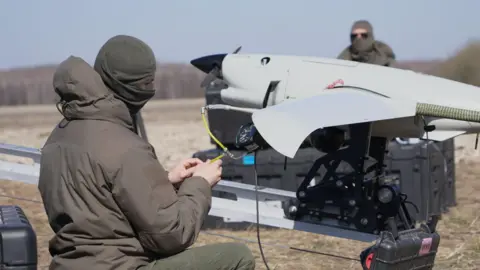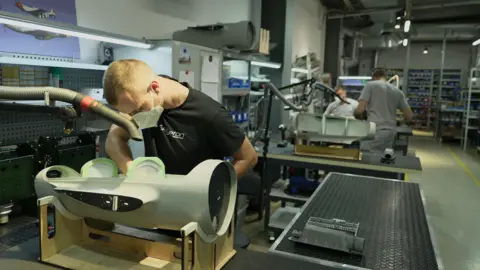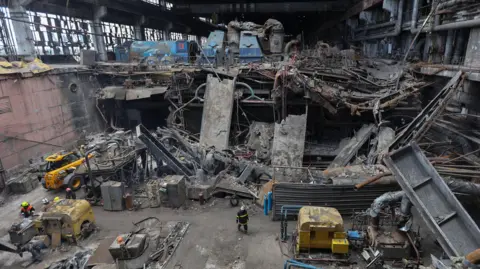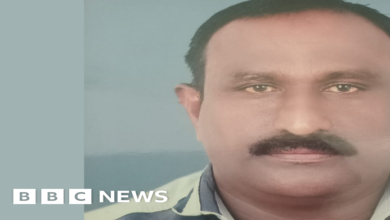
BBC News
 BBC
BBCAt a secret location away from prying eyes, Ukrainian engineers test a long-range drone called Raybird.
The machine, which looks like a mini plane with wings, is placed on a launchpad, stretched like an arrow on a crossbow and then shot into the air.
Raybird can fly non-stop for more than 20 hours and cover a distance of more than 1,000km (620 miles). It carries out missions to destroy targets both on the frontline and deep inside Russia.
Among their targets are oil refineries and fuel depots.
But after Russia and Ukraine reached separate agreements with the US on a partial ceasefire, missions like these should stop.
As well as agreeing to a maritime ceasefire in the Black Sea following talks this week in Saudi Arabia, the two countries committed to stop attacking each other’s energy infrastructure – something that had theoretically already been agreed.
Ukraine’s President Volodymyr Zelensky said Ukraine would implement these agreements immediately.
However, Oleksiy from Skyeton, the company that develops the Raybird, doubts that Moscow would adhere to the ceasefire.
“[Russians punch you in the face, then the next day they make an agreement but ask to tie up your hands. So the possibility that they will continue fighting remains,” explains Oleksiy.
Yet, this deal will also bring relief to Russia.
It’s estimated that this year alone, Ukraine carried out more than 30 attacks on Russia’s oil infrastructure using drones and other weapons.
They’ve recently hit some of the country’s largest oil facilities, like the Ufa oil refinery about 1,500km (932 miles) from the front line and Tuapse plant in Krasnodar region.
Russia’s oil refining capacity has dropped by about 10% as a result of drone attacks, according to Reuters.
And Moscow’s recent decision to extend the ban on petroleum exports shows that they’re feeling the pain.
Ukraine’s arsenal to carry out deep strikes is only growing. President Zelensky recently announced that Ukrainian engineers have designed a drone that has a range of 3,000 km (1,860 miles). That means it could reach not only Moscow, but even locations in Siberia.

Kyiv also claims that it has developed turbojet powered “missile-drones”. They fly at a much higher speed and so are harder to intercept.
Zelensky said Ukraine has successfully tested its first domestically made ballistic weapon and upgraded its cruise missile Neptune to hit ground as well naval targets. This missile was reportedly used to attack the Russian air base in the southern city of Engels last week, although Ukrainian officials neither confirm nor deny these reports.
The energy ceasefire deal is certainly good news for Ukraine too. Russia has been relentlessly targeting its power plants and stations across the country. At one point last year, Ukraine’s energy generation capacity dropped to a third of its pre-war level.
Last month, when temperatures dropped below zero, Russian drones hit a thermal power plant in Mykolaiv in southern Ukraine. A few days later, another massive aerial attack left more than 250,000 residents of Odesa without power and heating.
And lately, there has been a growing number of attacks on Ukraine’s gas infrastructure. Among regular targets are underground gas storage facilities in western Ukraine and production facilities in the central and eastern parts of the country.
 IGOR TKACHENKO/EPA-EFE/REX/Shutterstock
IGOR TKACHENKO/EPA-EFE/REX/ShutterstockMoscow’s aim is to reduce gas production in Ukraine, which is key to the country’s energy security, says Artem Petrenko, executive director of the Association of Gas Producers of Ukraine.
At the end of March, Gas storage facilities in Ukraine were only around 4% full, according to one monitoring group.
And if Russia continues its strikes, filling up those storage facilities will be extremely challenging, potentially leading to massive problems next winter.
Back at the testing ground, after several laps, the Raybird opens its parachutes and successfully lands in the field.
Oleksiy is satisfied with the results. He says that although it’s good to have a ceasefire, they still cannot afford to pause their work and the development of new weapons.
“Our enemy just wants to have a break, gather its strength and attack again,” he says. “We must be ready for that.”
https://ichef.bbci.co.uk/news/1024/branded_news/75a8/live/99899240-0a40-11f0-8cc5-ad01cd2fc9d6.jpg
2025-03-26 10:38:58





